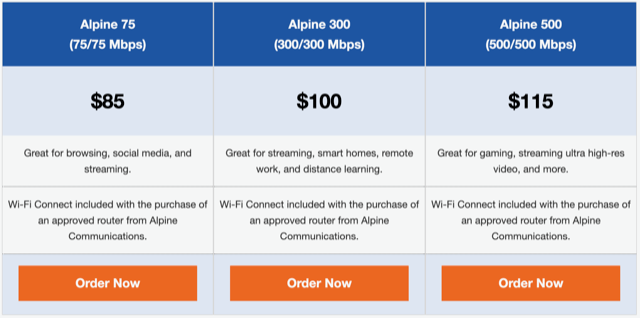May 21, 2023
Perhaps the most common question we hear from customers at Alpine Communications is: “what internet speed do I really need?”
It’s actually an excellent question, and the answer can depend on a number of factors—from the number of people in the home and the number of devices regularly used at once to the types of online activities that matter most to you. (For example, gaming and videoconferencing will require more bandwidth than checking emails!)
While Alpine Communications’ advanced fiber network is the most reliable internet you can get—and that reliability is consistent no matter what speed tier you choose—we offer different plans and tiers based on the speeds your household needs. Some homes or businesses may need or want greater speeds than others, while others prefer to try to save a little money on a slower maximum speed given their actual usage.
Below, we describe each of our speed tiers, as well as some of the key factors and considerations any customer should take when choosing an internet speed tier. And we help explain the reason why some speeds will work well for certain households or businesses, while others may simply need more. Still have questions? Call us or stop by! We’re local and happy to help.
75 MBPS
75 MBPS is generally considered the “entry-level” or most basic speed for high-speed internet service. While it is certainly a lower speed and does not take full advantage of fiber’s capabilities, for some households, 75 MBPS may be sufficient for most needs.
For example, 75 MBPS should enable customers to use three or four devices simultaneously for basic email, web browsing, and social media use—the kinds of everyday internet usage you’ve been accustomed to for years.
And 75 MBPS also lets you stream TV and movies and other videos and music on one or maybe two devices at a given time. But as streaming and other more data-intensive online activities like gaming do require much more information to be transmitted, 75 MBPS is likely to feel more sluggish, or even rather limiting, compared to faster speeds.
However, for a smaller home or business, or even for a household with just one or two users, residents may be able to get by with a 75 MBPS tier for most internet uses. Just keep in mind that multiple users streaming at the same time will likely notice the need for a speed tier upgrade.
300 MBPS
The 300 MBPS tier is where fiber internet’s prowess really starts to show off. Though still not close to fiber’s fullest capabilities, 300 MBPS is a solid option for many customers.
For starters, at 300 MBPS, multiple people in one household can generally use around five to nine devices at once for basic email, web browsing, and social media use. More TV and movies can be streamed simultaneously as well, with 300 MBPS providing streaming capability for three or four devices at one time.
You’ll also be able to enjoy streaming with more pristine picture at 300 MBPS, as that speed tier opens up 4K resolution (assuming your smart TV or other streaming device is compatible with it).
Many families opt for our 300 MBPS tier to ensure they have the speed they need for streaming, working, or learning on multiple devices at once.
500 MBPS
For users looking for the best internet and streaming experience available—and to take full advantage of fiber’s advanced technology—the 500 speed tier is the clearest choice. At this speed, fiber internet simply pours data into your home, powering your devices with the internet they need to perform at their best. With 500 fiber internet, you and your family can easily use ten or even more devices at the same time to surf the web, check email, and play on social media.
Streaming TV, movies, and other video on multiple devices simultaneously is a cinch with 500, so you’ll never need to ration out streaming times in your home again. And the streaming quality of 500 fiber internet is just exemplary, with 4K’s brilliant resolution making colors and textures pop on all of your screens. At this tier, you can also power a fully connected smart home (think Alexa, security cameras, and more) without noticing a slowdown on your device.
Online gaming, which can keep players engaged for hours (and build skills regularly used in “real life,” too!), is incomparably better with the 500 speed tier for any gamer. 500’s greater bandwidth capacity allows more data to flow up and down seamlessly, preventing lag and other delays and choppiness that stymie gamers on slower speeds.
We hope this guide helps you assess your internet speed needs for your household or business. It may even help “diagnose” why you may notice some less-than-stellar internet performance—i.e., when too many people are using too many devices for intensive online activities simultaneously!
The friendly and knowledgeable support team specialists at Alpine Communications are available to answer any question you may have about which speed is best for you or any other question you may have about our fiber network. So feel free to reach out at your convenience!
And to learn more about Alpine Communications and why its fiber internet cannot be beat, be sure to check out our social pages!


